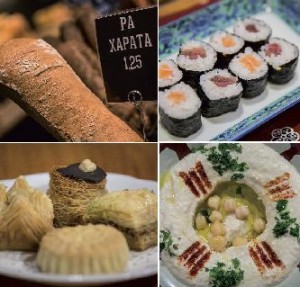History shows that great innovations take place in societies that have been able to accommodate contributions from other cultures and that have taken advantage of the arrival of other groups to transform themselves and strengthen their creativity.

Borrowings from other languages are frequent in culinary vocabulary. Above examples of foreign foods: Italian ciabatta, Japanese sushi, baklava and hummus from the Middle East, as prepared by Lebanese restaurant Sannin in Gràcia.
Photos: Pere Virgili.
Counting is often a way to blur reality, to create uniformity out of diversity. But counting is also a way to make it possible to understand phenomena that are too often hard to grasp. When we count languages, we do both things at the same time. On one hand, we treat something that is basically ungraspable as an object and, on the other, we depict a reality that is often hidden. In Barcelona, at least, there are speakers of 150 languages from around the world, but many of these languages are hidden in the stories of Barcelonians who have been told that we live in a bilingual city where their language is out of place.
The city’s linguistic diversity has grown enormously since the beginning of this century. This growth presents us with new challenges, the most exciting of which is how to seek ways to coexist without giving up diversity. This city that wants to be welcoming cannot ignore the personal and cultural backgrounds of its inhabitants. It cannot live distanced from the ties it now has with other places all over the world through its residents. When the University of Barcelona’s Endangered Languages Study Group proposed taking stock of the languages spoken in Catalonia, besides painting as accurate a picture as possible of our diversity, it wanted to find answers to two fundamental questions: what should we do with these languages and what do they give us?
Obviously, we could copy the response that other cultures have given to these questions: we shouldn’t do anything, it’s something for their speakers to deal with, and they don’t provide us with anything, what happens to them doesn’t matter to us. But the history of languages shows that great innovations take place in societies that have been able to accommodate contributions from other cultures and that have taken advantage of the arrival of other groups to transform themselves and strengthen their creativity. Moreover, migratory movements clearly demonstrate that those with clear links to their community of origin are more easily incorporated into a group. In that sense, linguistic diversity gives us the chance to change ourselves and helps us to strengthen the ties of coexistence – two good reasons not to ignore it.
Languages form part of people’s cultural background, although this background has too often been ignored or devalued, to the point that even those with this background fail to value it. The first step, then, is to acknowledge these languages, so that everyone can appreciate their value. And this acknowledgement is not necessarily an official stance – sometimes it is enough to simply not question their value. To not label them dialects, or primitive languages (do we need to remind ourselves that the world has no primitive languages or developed languages?). To not assume that they are a hindrance for their speakers, or an obstacle for their children.
It is not uncommon to find families that do not pass on their language of origin to their children, to make it easier for them to integrate at school. But in doing so they lose the essential foundation for learning any other language: having one, consolidated language. Acknowledgement inevitably means no language-based discrimination. Not putting up barriers but, if possible, promoting learning. One only needs to think about how much we invest in learning foreign languages to realise that ignoring those within our reach is an incomprehensible misuse of money.
When these languages form part of our linguistic landscape, what they give us becomes clearer. Languages are alternative ways of explaining reality, so having as many ways of understanding things as possible makes us a more flexible and versatile community. The diversity of languages in Barcelona makes it possible to bring together an infinite number of representations of what shapes us.
The chance to go beyond our limits
People count in Barcelona in as many different ways as there are number systems across their languages. They use the decimal system, as well as the base 20 and base five numeral systems, giving us up to 20 different ways of counting from six to nine (5+1, 5+2, 5+3, 5+4, or 3+3, 3+4, 4+4, 4+5, or 3+3, 7, 4+4, 9, etc.). 400 can be 4 x 100, or 20 x 20, or 2 x 200. In the languages spoken in Barcelona, we find terms to describe everyday things for which we have no name: my father’s wife who is not my mother. And there are a huge number of personal pronoun systems that do not differentiate between men and women. The examples are endless and, above all, impossible to put into worlds, but they all give us the chance to go beyond our limits, because they all provide us with new resources that enhance our creativity.
And as well as giving us the potential to multiply experiences, these languages have filled our everyday lives with new words that describe so many different realities, which we have also made our own, through words. These are some of the latest borrowings incorporated into our language: alquena, asiago, aualé, babaganuix, baclaua, caiac, coulis, dashi, dóner kebab, falàfel, haik, hijab, hummus, mutàbal, nicab, pròvola, sake, sari, sashimi, sushi, tabule, tagín, tatami, xapata, xauarma. These and many more will serve as evidence of the fact that Barcelona has changed radically at the start of the third millennium, nourished by the input of the ancestors of future Barcelonians.


